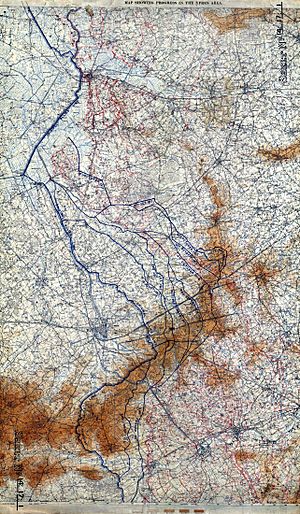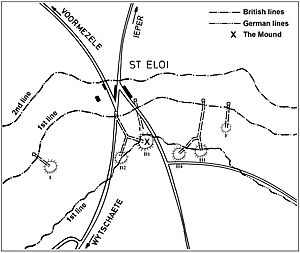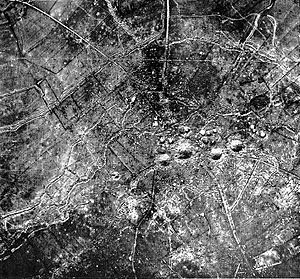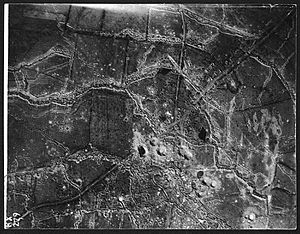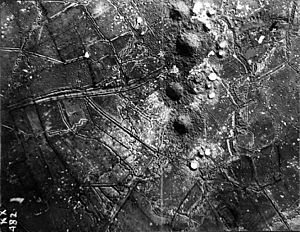Actions of St Eloi Craters facts for kids
Quick facts for kids Actions of St Eloi Craters |
|||||||||
|---|---|---|---|---|---|---|---|---|---|
| Part of the First World War | |||||||||
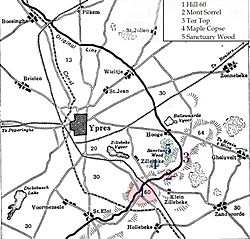 St Eloi |
|||||||||
|
|||||||||
| Belligerents | |||||||||
| Commanders and leaders | |||||||||
| Douglas Haig | Erich von Falkenhayn | ||||||||
| Units involved | |||||||||
| 3rd Division, 2nd Canadian Division | 46th Reserve Division | ||||||||
| Casualties and losses | |||||||||
| 2,233 | 1,605 | ||||||||
The Actions of St Eloi Craters were a series of battles during the First World War. They took place from March 27 to April 16, 1916. These fights happened near a village called Sint-Elooi (also known as St Eloi) in Belgium. St Eloi is about 5 km (3.1 mi) south of Ypres.
During these actions, British and Canadian soldiers fought against German forces. The British started by digging tunnels under the German lines. They placed huge bombs, called mines, underground. These mines exploded on March 27, 1916, creating massive craters. British troops then attacked, capturing most of the craters.
However, the battlefield became very confusing due to the explosions. The ground was full of new and old craters and shell-holes. It was hard for soldiers to know where they were. German forces launched a strong counter-attack and managed to take back some of the captured craters. Canadian troops then took over the front lines. They faced terrible conditions, including constant rain, thick mud, and heavy artillery fire. Despite several attempts, the Canadians could not fully regain the lost ground. The battle showed how difficult it was to hold ground in such a chaotic and muddy environment.
Contents
Why St Eloi Was Important
The Ypres Area: A Key Battlefield
Ypres was a very important city during the First World War. It was surrounded by low hills, like Kemmel Hill and Hill 60. These hills gave whoever controlled them a great view of the area. This meant they could easily see enemy movements and direct artillery fire.
The land around Ypres was often wet and muddy. There were many small streams and ditches. Woods like Polygon Wood provided some cover. But the open fields between the woods were dangerous. Soldiers had little protection there. Controlling the high ground was key to winning battles in this area.
Underground Warfare: The Tunnellers
The fighting at St Eloi was special because of the underground war. Both sides dug tunnels under no man's land. This was the dangerous area between the enemy trenches. Soldiers who were miners in civilian life became specialist tunnellers. They dug deep tunnels, sometimes 60–90 ft (18–27 m) underground.
The goal was to place large bombs, called mines, under enemy trenches. When these mines exploded, they would destroy enemy defenses. They would also create huge craters. These craters could then be captured by attacking soldiers. This underground battle was very dangerous. Tunnellers faced the risk of enemy counter-mines and tunnel collapses.
The First Battle for St Eloi
In March 1915, the Germans attacked St Eloi. They used mines to blow up parts of the village. They captured the village and a nearby spoil heap called the Mound. This Mound was about 30 ft (9.1 m) high. It gave the Germans a good view of the British lines.
British soldiers fought hard to take back the village. They succeeded in recapturing most of it. But the Germans held onto the Mound. This gave them an advantage. Both sides continued to fight underground in this area.
Getting Ready for Battle
British Plans for Attack
The British wanted to take back the Mound and the German positions around St Eloi. They had been planning this attack since late 1915. British tunnellers worked hard to dig six deep tunnels under the German lines. These tunnels were very deep, sometimes 80–120 ft (24–37 m) below the surface.
The British placed huge amounts of explosives in these tunnels. Some mines contained over 13,500,000 lb (6,100,000 kg) of ammonal, a powerful explosive. The tunnellers had to be very careful. They could sometimes hear German miners working above them. They also had to hide the dirt they dug out. They carried it away in sacks and hid it in dips in the ground.
German Defenses
The Germans knew the British were active underground. Their own mines in the area were often flooded. But they didn't think a big British attack was coming. On March 26, 1916, a German listening post heard British soldiers talking about mines. As a safety measure, the German front line soldiers moved back. This meant fewer soldiers would be caught in any explosions.
The Battle Begins
March 27: The Mines Explode
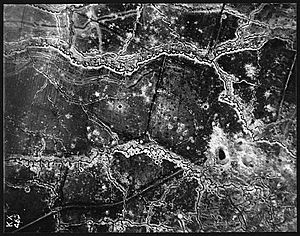
At 4:15 a.m. on March 27, the British mines exploded. Witnesses said it looked like a "long village was being lifted through flames into the air." The explosions destroyed the Mound and German trenches. About 300 German soldiers were buried.
British infantry attacked immediately. They quickly captured most of the craters. But they missed two key craters, numbers 4 and 5. German artillery fire started quickly, making it hard for the British to dig in. The ground became very muddy due to rain and destroyed drainage systems.
German Counter-Attack
The Germans were confused at first. But they soon launched counter-attacks. They tried to take back the lost ground. British artillery fire stopped some of these attacks. On March 30, the British finally captured craters 4 and 5. The Germans then brought in more troops. They started digging new defensive lines.
The Canadians Take Over
The British troops were exhausted. So, the 2nd Canadian Division took over the front lines on April 3. This was a difficult task. The battlefield was still very messy. The captured ground had not been properly secured. The Canadians faced terrible conditions. The trenches were flooded and full of mud. There were no good paths to bring supplies forward. Wounded and dead soldiers lay everywhere.
April 5/6: German Victory
On the night of April 5/6, the Germans launched a major counter-attack. They started with a heavy artillery bombardment. This destroyed much of the Canadian defenses. German infantry then broke through the Canadian lines. They quickly recaptured craters 2, 3, 4, and 5.
The battlefield was so changed that it was hard to tell which craters were which. Canadian and British commanders were confused for days. They received wrong reports about who held what. It was impossible to raise one's head without being shot by snipers. The Germans quickly dug in and held their new positions. British counter-attacks failed.
After the Main Battle
The Canadians tried several times to recapture the craters. But they were always pushed back. The constant shelling, mud, and lack of sleep wore out the soldiers. Battalions had to be replaced every few days.
On April 16, the weather cleared enough for planes to take photos. These photos showed that the Germans had built a new trench around the craters. This confirmed that the Germans held the key positions. Plans for more attacks were cancelled. For the next two weeks, both sides just exchanged artillery fire.
Aftermath of the Battle
Who Won and What Was Learned?
The Actions of St Eloi Craters ended in a German victory. They managed to recapture the important craters. The British and Canadians suffered heavy losses. On March 27 alone, the British lost over 850 men. The 2nd Canadian Division had over 1,373 casualties by April 16. The Germans also had significant losses, with over 1,600 casualties.
The battle taught both sides important lessons. It showed that while mines could capture ground, holding it was much harder. Especially on a narrow front where the enemy had good observation. The terrible conditions, like mud and constant shelling, made it very difficult for troops to stay in position.
Later Mining at St Eloi
Mining continued at St Eloi even after this battle. For the big Battle of Messines in 1917, the British dug an even larger mine at St Eloi. This mine was called Queen Victoria. It was 42 m (138 ft) deep and contained 95,600 lb (43,400 kg) of explosives.
This massive mine was one of 19 large mines that exploded at the same time on June 7, 1917. This was one of the biggest non-nuclear explosions ever. The explosion destroyed some of the old craters from 1916. British troops then captured the German lines at St Eloi.
Memorials
There is a special memorial in Saint-Eloi called the 'Monument to the St Eloi Tunnellers'. It was put up in 2001. It has clear plaques that tell the story of the mining work. There is also a flagpole with the British flag. In 2003, a field gun was added to the memorial. The Canadian soldiers who fought here are remembered at the nearby Hill 62 (Sanctuary Wood) Memorial.
Images for kids
See Also
- Battle of Messines (1917)
- Mines in the Battle of Messines (1917)
- List of Canadian battles during the First World War
- St. Eloi Mountain, Canada
- Noel Mellish, chaplain who won the VC


